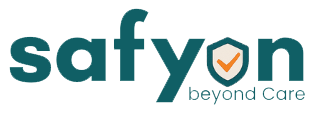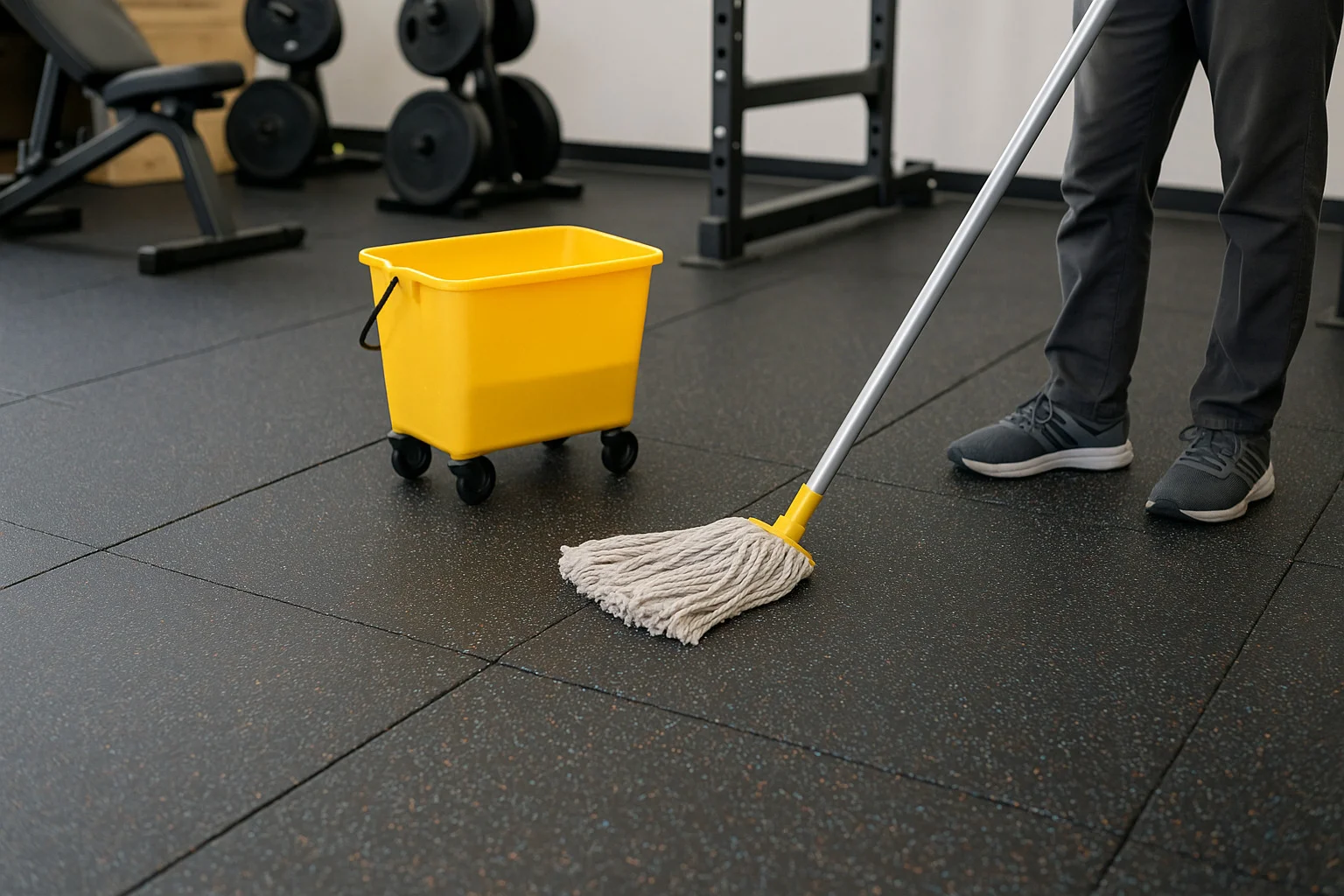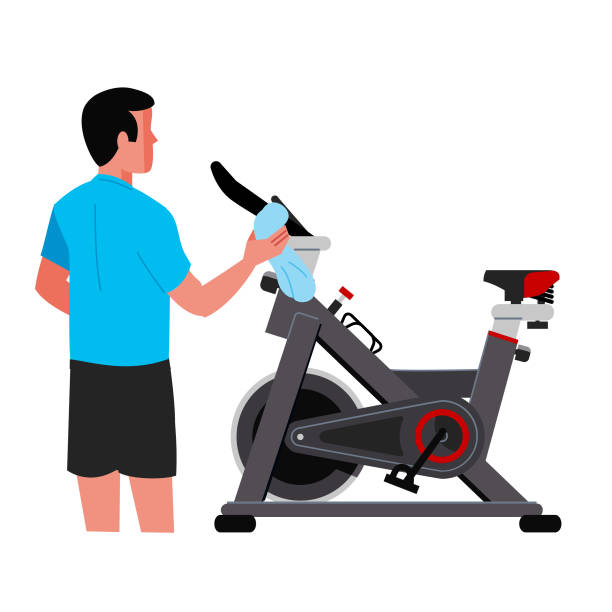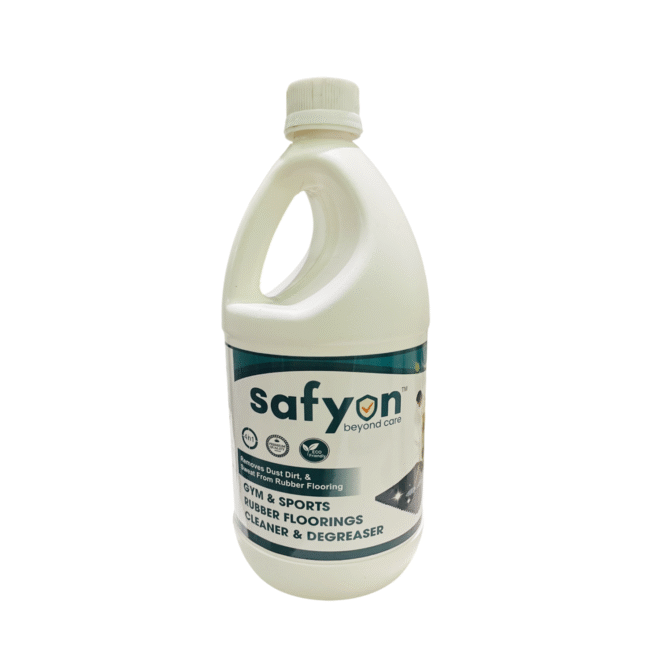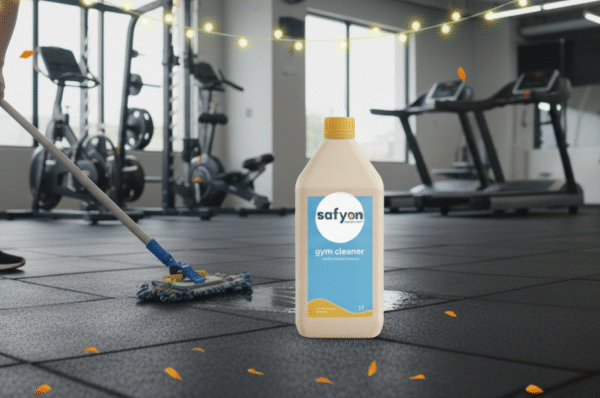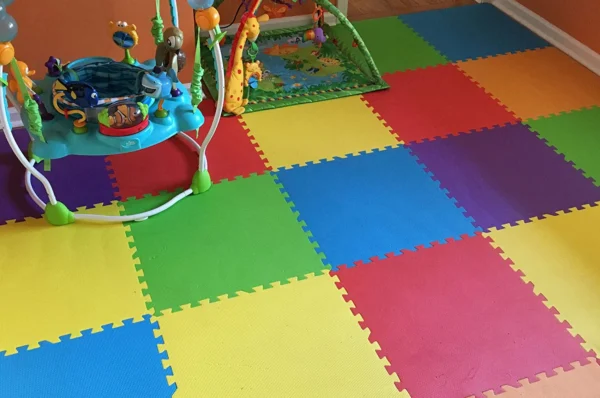Rubber gym flooring is built to take a beating—sweat, chalk, shoe traffic, dropped weights, and daily mopping. But tough doesn’t mean maintenance-free. The wrong cleaner can leave residue, dull the surface, or even degrade the rubber over time. The right solution keeps floors clean, grippy, odor-free, and long-lasting.
In this comprehensive guide, you’ll learn:
- How rubber floors get dirty (and what that means for your cleaning plan)
- The best types of cleaning chemistries for rubber
- A daily–weekly–monthly cleaning schedule that actually works
- DIY vs. professional cleaners—and when to choose which
- How to use Safyon Gym Rubber & Flooring Cleaner for reliable results
- Troubleshooting stains, odors, sweat film, chalk, and sanitization
- A printable checklist and FAQs
Why Rubber Flooring Needs a Specific Cleaning Approach
Rubber flooring (tiles, rolls, interlocking mats) is popular because it’s durable, shock-absorbent, and relatively low maintenance. However, rubber is also porous and can trap:
- Sweat salts and body oils
- Dust, chalk, and micro-debris from shoes
- Residues from harsh cleaners or fabric softeners used on mop heads
- Odor-causing bacteria in micro-pores
Using a harsh alkaline/solvent cleaner or bleach daily can cause drying, discoloration, and loss of elasticity. Using a heavy, soapy cleaner can leave a slippery film that attracts even more dirt. The sweet spot is a neutral to mildly alkaline, non-foaming, residue-free formula designed for rubber and sports floors.
Gym Deep Cleaning & Sanitization Service (Up to 500 sq ft)
We bring our own professional-grade tools and Safyon cleaning products:
-
Wet & dry vacuum cleaners
-
Floor scrubbers (safe for rubber floors)
-
Glass & mirror cleaning kits
-
Eco-friendly, non-corrosive disinfectants
-
Stainless steel polishers
-
Tile & grout cleaning solutions
In stock
What Makes a Great Rubber Floor Cleaner?
When comparing solutions, look for:
- pH Balance (Neutral/Mild): Safer for rubber polymers and adhesives.
- Low/Controlled Foam: Works with mop, bucket, autoscrubber, or spray-and-wipe without sticky residue.
- Residue-Free Rinse: Leaves the surface grippy, not slick.
- Odor Control: Targets sweat odors without heavy perfumes.
- Non-corrosive, Non-bleaching: Won’t fade or pit the surface.
- Disinfectant-compatible routine: Plays nicely with a periodic sanitization step when needed.
- Economical Dilution: Concentrates that stretch far keep total cost of ownership low.
Safyon Gym Rubber & Flooring Cleaner was developed exactly with these criteria in mind—safe on rubber, residue-free finish, and optimized for gyms, yoga studios, CrossFit boxes, and sports floors.
The 3-Layer Cleaning Plan: Daily, Weekly, Monthly
1) Daily Maintenance (Fast & Effective)
Goal: Remove sweat film, dust, light footprints, and keep grip consistent.
- Dry Debris Removal: Dust mop or vacuum at opening and closing time.
- Damp Mop / Autoscrub:
- Safyon Dilution (Daily Clean): 1:50 (20 ml per 1 L of water).
- Use a clean microfiber flat mop or autoscrubber with soft pads.
- Work in sections; do not flood the floor.
- Allow to air dry—no rinse needed when diluted correctly and soil load is normal.
Pro tip: Use separate, labeled mop heads for washrooms vs. floor areas to avoid cross-contamination.
2) Weekly Deep Clean (Restore the Grip)
Goal: Remove embedded grime, chalk buildup, and product residue.
- Pre-vacuum: Especially around racks, rigs, and edges.
- Safyon Deep-Clean Dilution: 1:30 (33 ml per 1 L of water).
- Agitation: Use a soft/medium pad with an autoscrubber or a deck brush in tight zones.
- Rinse (If Soil Load Is Heavy): Quick water pass or a damp mop with clean water, then let dry.
Pro tip: Rotate your weekly deep clean across zones (free weights, cardio, class studio) to minimize downtime.
3) Monthly / As-Needed Sanitization
Goal: Reduce odor and microbial growth in high-sweat areas.
- Clean first, sanitize second. Dirt blocks sanitizers.
- Use a rubber-safe, non-bleach sanitizer (check manufacturer label for compatibility).
- Light mist with a sprayer; let dwell per label; wipe/dry.
- Never mix chemicals. If unsure, alternate days for cleaning vs. sanitizing.
Comparing Common Cleaning Solutions (Pros & Cons)
| Solution Type | Pros | Cons | Verdict for Rubber Floors |
|---|---|---|---|
| Neutral pH Sports Cleaner (e.g., Safyon) | Safe on rubber, residue-free, odor control, economical | Needs correct dilution | Best overall |
| Mild Dish Soap + Water (DIY) | Cheap, available | Foamy, can leave film, attracts dirt | Emergency only |
| Vinegar Mix (DIY) | Deodorizes | Acidic; can dull rubber; strong smell | Avoid |
| Bleach/Chlorine | Strong disinfectant | Corrosive; fumes; discoloration; damages adhesives | Avoid for routine |
| Strong Alkaline Degreasers | Cuts oil fast | Can degrade rubber, leaves residue | Avoid |
| Alcohol-heavy Sprays | Fast dry | Can dry out surface; flammable; streaks | Use sparingly |
| Steam Cleaning | No chemicals | Excess heat/humidity may affect glue seams | Use with caution |
How to Use Safyon Gym Rubber & Flooring Cleaner
Safyon is designed for rubber flooring, gym mats, yoga mats, sports courts, and fitness centers. It cleans sweat film, oils, chalk dust, and everyday grime without leaving a slippery residue.
Daily Use (Most Gyms):
- Dilution: 1:50 (20 ml per 1 L water)
- Method: Microfiber damp mop or autoscrubber
- No rinse needed when floor isn’t heavily soiled
Weekly Deep Clean:
- Dilution: 1:30 (33 ml per 1 L water)
- Method: Autoscrubber + soft/medium pad or deck brush
- Rinse if you lifted heavy soil
Spot & Edge Cleaning:
- Spray a 1:20 mix on stubborn marks (chalk, heel scuffs)
- Agitate lightly with a soft brush; wipe
Yoga Mats & Small Rubber Accessories:
- Wipe with 1:50 dilution on a microfiber cloth
- Let air-dry completely before stacking/rolling
Safety: Wear gloves if you have sensitive skin. Store closed, away from direct sun. Never mix with bleach or other chemicals.
Gym Rubber Floor Cleaner – 1 Litre (Regular Use, Non-Slippery Formula)
Where to Use:
✔️ Commercial Gyms
✔️ Home Gyms
✔️ Fitness Studios & Yoga Centers
✔️ Sports Clubs & CrossFit Boxes
In stock
Preventing Slipperiness & Odor—The Two Big Problems
1) Slippery Floor Syndrome
Cause: Soap residues, fabric softener on mop heads, over-diluted or under-diluted cleaners, dirty water reuse.
Fix:
- Switch to Safyon at correct dilution.
- Rinse once with clean water to remove past residue.
- Use dedicated, residue-free laundry detergent for mop heads (no softeners).
- Change mop solution frequently and use dual-bucket if possible.
2) Persistent Odor
Cause: Sweat and bacteria in micro-pores; stagnant water around edges.
Fix:
- Improve airflow; keep floor dry after cleaning.
- Weekly deep clean with Safyon 1:30.
- Periodic compatible sanitization after cleaning (never mix chemicals).
- Edge detailing—vacuum the corners and under machines.
Autoscrubber vs. Mop: What’s Better?
- Autoscrubber Advantages: Faster, consistent pressure, controlled solution feed, better recovery—ideal for ≥1000 sq ft areas.
- Mop Advantages: Lower cost, great for small studios, quick spot cleans.
- Hybrid Approach: Many gyms damp-mop daily and autoscrub 2–3 times a week.
Pad Choice: Soft to medium pads only. Avoid aggressive pads that can abrade or polish the rubber to a glossy, slippery finish.
Setup Guide: A 15-Minute Daily Routine
- Open: Quick vacuum/dust mop high-traffic lanes.
- Mix: Safyon at 1:50 in a clean bucket/tank.
- Damp Mop/Autoscrub: Work from far corner to exit; overlap passes.
- Edges/Spots: Hit scuffs with a spray of 1:20, wipe.
- Dry: Allow 5–10 minutes air dry before foot traffic peaks.
- Close: Quick dry pass or spot mop in sweat zones; empty tanks; rinse pads/mops.
Result: Floors look matte-clean, grippy, and odor under control.
Cost Control: Make Cleaning Pay for Itself
- Use concentrate wisely: Correct dilution saves 30–40% chemical usage.
- Pad & Mop Lifecycle: Wash properly; replace when worn—better cleaning in fewer passes.
- Zoning: Clean heavy-use zones more frequently, not entire facility every time.
- Inventory: Keep a 5- or 10-litre Safyon can for gyms; 500 ml / 1 L for studios or PT rooms.
When to Replace or Reseal Rubber
Cleaning won’t fix structural issues like:
- Cracks, gouges, curling seams
- Permanent chemical burns from harsh agents
- Flattened shock zones under impact points
If these appear, consult flooring pros. Meanwhile, proper cleaning with Safyon extends life and postpones costly replacement.
Common Mistakes to Avoid
- Using bleach or strong degreasers as daily cleaners
- Over-wetting floors—water seeping into seams
- Fabric softener on mop heads (leaves slick film)
- Ignoring dwell time—give the cleaner 2–3 minutes on tough spots
- Not changing dirty solution or pads frequently
- Mixing chemicals (unsafe and ineffective)
Quick Troubleshooting
- White haze after cleaning: Previous soap residue—do a rinse cycle, then switch to Safyon 1:50.
- Footprint shadows: Increase dwell time; use 1:30 weekly deep clean.
- Black scuffs: Spot treat with 1:20 and a soft brush; avoid abrasive pads.
- Seam darkening: Reduce water volume; clean with damp (not wet) method.
Why Choose Safyon for Rubber Gym Floors?
- Rubber-Safe Formula: Neutral-leaning chemistry protects polymers and adhesives.
- Residue-Free Finish: Maintains traction and the natural matte look.
- Odor Management: Targets sweat odors without heavy perfumes.
- Flexible Use: Mop, spray-and-wipe, or autoscrubber.
- Economical: Concentrate stretches far (1:50 for daily use).
- Versatile: Safe for rubber flooring, gym mats, yoga mats, and many sports floors.
Available Sizes: 500 ml, 1 L, 2 L, 5 L, 10 L
Also Explore: Safyon Washroom Cleaner, Hand Wash (for member hygiene stations), Machine Cleaner, Foam Cleaner (for upholstery), Polish solutions for metal/fixtures.
Printable Daily–Weekly Checklist
Daily:
- Dry sweep/vacuum
- Damp mop with Safyon 1:50
- Spot clean edges/scuffs (1:20)
- Air-dry, improve ventilation
Weekly:
- Autoscrub or brush with Safyon 1:30
- Rinse if heavy soil
- Launder mops/pads (no softener)
Monthly / As Needed:
- Compatible sanitization after cleaning
- Edge detailing and under-machine vacuum
FAQs (for Gym Owners & Facility Managers)
Q1. Can I use bleach to kill germs on rubber flooring?
A. Not recommended for routine cleaning. Bleach can discolor and degrade rubber. Clean with Safyon first; if sanitization is required, use a compatible, non-bleach sanitizer on alternate cycles.
Q2. Why does my rubber floor feel slippery after mopping?
A. Likely residue from soapy cleaners or fabric softeners. Switch to Safyon at the correct dilution (1:50), rinse once to remove old residue, and launder mop heads without softener.
Q3. Do I need to rinse after using Safyon?
A. Not for daily cleaning at 1:50, unless soil load is heavy. For deep cleaning (1:30) or heavy dirt, a quick rinse helps.
Q4. Will Safyon damage the matte finish?
A. No—Safyon is designed to clean without glossing or leaving films, preserving natural traction.
Q5. Can I use Safyon on EVA foam or PVC floors?
A. Yes, in most cases at 1:50. Always test a small, hidden patch first.
Q6. Is autoscrubber required?
A. No. It’s helpful in large facilities for speed and consistency, but damp mopping with Safyon is effective for studios and smaller gyms.
Q7. What about stubborn chalk or heel scuffs?
A. Pre-spray with Safyon at 1:20, agitate gently with a soft brush, then wipe.
Q8. How do I control odors long term?
A. Clean daily (1:50), deep clean weekly (1:30), improve airflow, and add a compatible sanitization step monthly.
Q9. How much Safyon do I need each month?
A. As a rough guide, a 5 L can typically supports daily cleaning for a mid-size gym (~200–300 m²) for 1–2 months at 1:50, depending on soil and frequency.
Q10. Can I use one product for floors and yoga mats?
A. Yes. Safyon at 1:50 on a microfiber cloth works well for mats and small accessories—just let them dry fully before storing.
